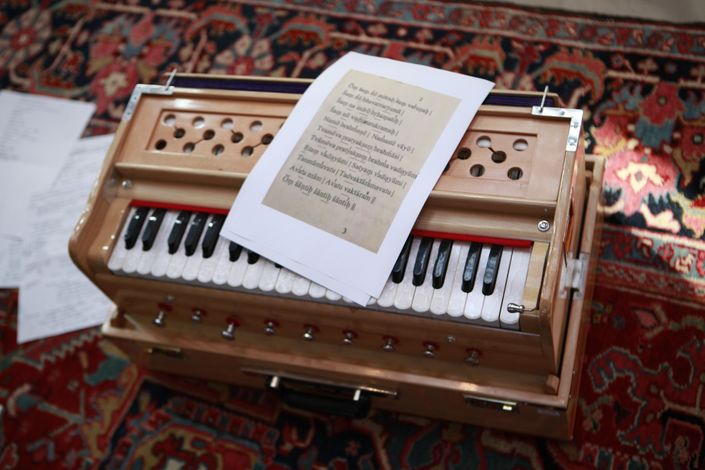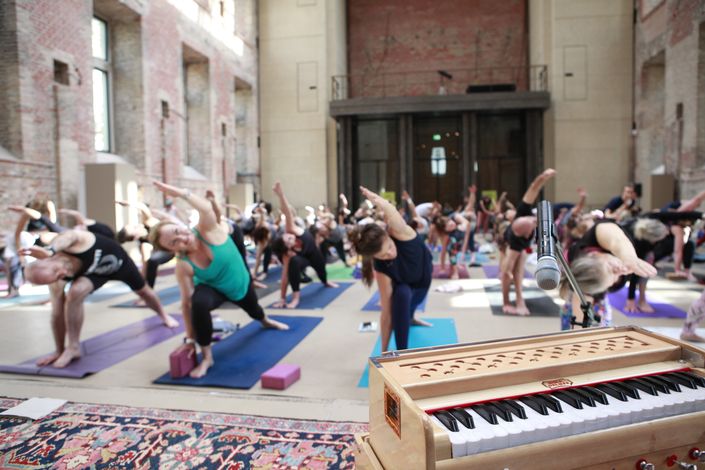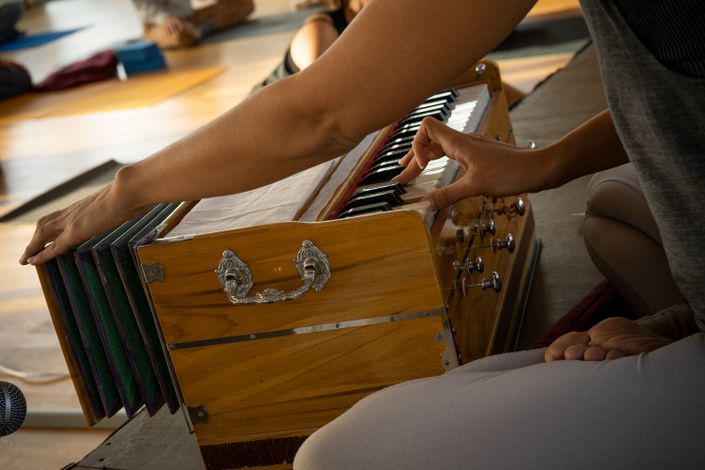Learn to Play the Harmonium
Mantra, Music, Chanting, Kirtan & Harmony
THE 1ST IN THE THREE-VOLUME COURSE OFFERS TEACHERS AND STUDENTS THE OPPORTUNITY TO EXPLORE THE MOST PLAYED SECTIONS OF THE JIVAMUKTI YOGA CHANT BOOK:
VOL. 1: "DAILY CHANTS, MANTRAS, & PRAYERS" PART I (1-18)
What is a Harmonium?
Harmonium is an instrument invented in Europe during the 19th century and is a particularly popular instrument in Indian/spiritual music. The harmonium’s sound is powered by pressurized air passing through a series of reeds. The wooden box-like instrument has a keyboard along its topside to manoeuvre the reeds while air is breathed through the bellows, resembling those of an accordion.
With this comprehensive course we invite you to dive into a deeper engagement with the senses and re-align with divine sound vibrations radiating within.
About Harmonium Chanting
“The nature of reality is vibration. Sound is the source of all manifestations. Hazrat Inayat Khan said, ‘The knower of the mystery of sound knows the mystery of the whole universe.’ When you experience the power of sound—which is the power of music—you hold the key, which can alter your destiny. Mantra provides a powerful tool that can release you from your past karmas (or conditioned habits) which reside in your body as mental patterns.”
-Sharon Gannon
“Chanting mantra is a sacred yogic sadhana. It is a practice of inviting yogic wisdom to directly permeate your life. When you do this with sincerity, these mystical sounds and their healing vibrations have the capacity to open up sacred knowledge, wisdom and peace within you.“
-Jivamukti Chant Book Intro by Manorama
“The word Mantra means man (thought or heart) + tra (tool) so Mantra is a tool to calm the mind and help us access our spiritual heart.”
-Jivamukti Chant Book intro by Manorama
What is Bhakti?
Bhakti - sometimes called Yoga of Feeling or of the Heart - is one of the four main paths of yoga and one of the Five Tenets of Jivamukti. Simply, it means devotion to God, and involves dedicating our practice to something higher than our own ego. Some of the main Bhakti practices cherished by Jivamukti are chanting kirtan, and Satsang. By learning to play the harmonium, yoga teachers will have the chance to work Bhakti into their yoga classes or for students of yoga, the opportunity to elevate the fire of emotion to devotion.

Curriculum
- V1 8m Scales (Full, with Petros) (7:28)
- V1 8m Scales (just keys) (7:28)
- V1 2m 1. Oṁ 1st Version (Full, with Petros) (2:19)
- V1 2m 1. Oṁ 1st Version (just keys) (2:21)
- V1 2m 1. Om 2nd version (Full, with Petros) (1:26)
- V1 2m 1. Oṁ 2nd Version (just keys) (1:27)
- V1 3m 2. Śāntiḥ Śāntiḥ Śāntiḥ (Full, with Petros) (3:21)
- V1 3m 2. Śāntiḥ Śāntiḥ Śāntiḥ (just keys) (3:22)
- V1 3m 3. Oṁ bolo sad guru maharaj a ki jai (Full) (2:41)
- V1 3m 3. Oṁ bolo sad guru maharaj a ki jai (keys) (2:42)
- V1 5m 4. Lokāḥ... version 1 (Full, with Petros) (4:59)
- V1 5m 4. Lokāḥ... version 1 (just keys) (4:59)
- V1 4m 4. Lokāḥ... version 2 (Full, with Petros) (3:30)
- V1 4m 4. Lokāḥ... version 2 (just keys) (3:32)
- V1 5m 5. Guru Mantra… (Full, with Petros) (5:09)
- V1 5m 5. Guru Mantra… (just keys) (5:10)
- V1 5m 5. Guru B (full) (4:57)
- V1 5m 5. Guru B (keys) (4:58)
- V1 4m 6. Oṁ śarīraṃ surūpaṁ... (full) (4:13)
- V1 4m 6. Oṁ śarīraṃ surūpaṁ... (keys) (4:13)
- V1 6m 7. Oṁ guruḥ satyaṁ gurur jñānaṁ... (Full, with Petros) (5:37)
- V1 6m 7. Oṁ guruḥ satyaṁ gurur jñānaṁ... (just keys) (5:38)
- V1 4m 8 Oṁ satyaṁ jñānam ānandaṁ brahma (Full, with Petros) (4:13)
- V1 4m 8 Oṁ satyaṁ jñānam ānandaṁ brahma (just keys) (4:13)
- V1 4m 8 Oṁ satyaṁ jñānam ānandaṁ brahma (full) (4:10)
- V1 4m 8 Oṁ satyaṁ jñānam ānandaṁ brahma (keys) (4:13)
- V1 4m 9. Oṁ satyaṁ śivaṁ... (Full) (4:02)
- V1 4m 9. Oṁ satyaṁ śivaṁ (keys) (4:03)
- V1 5m 10. The Gāyatrī Mantra (Full, with Petros) (4:31)
- V1 5m 10. The Gāyatrī Mantra (keys) (4:33)
- V1 3m 11. The Mahā Mṛtyuñjaya Mantra (Full, with Petros) (3:28)
- V1 3m 11. The Mahā Mṛtyuñjaya Mantra (keys) (3:30)
- V1 5m 12. Oṁ sarveṣāṁ svastir bhavatu... (Full, with Petros) (5:18)
- V1 5m 12. Oṁ sarveṣāṁ svastir bhavatu... (keys) (5:19)
- V1 3m 13. Oṁ sarve bhavantu sukhinaḥ... (Full, with Petros) (3:08)
- V1 3m 13. Oṁ sarve bhavantu sukhinaḥ... (keys) (3:11)
- V1 5m 14. Oṃ asato mā sad-gamaya... (Full, with Petros) (4:43)
- V1 5m 14. Oṃ asato mā sad-gamaya... (keys) (4:46)
- V1 5m 15. Oṁ pūrṇam adaḥ pūrṇam idaṃ... (Full, with Petros) (5:17)
- V1 5m 15. Oṁ pūrṇam adaḥ pūrṇam idaṃ... (keys) (5:18)
- V1 6m 16. Oṁ sat-saṅgatve nissaṅgatvam... (Full, with Petros) (5:47)
- V1 6m 16. Oṁ sat-saṅgatve nissaṅgatvam... (Just keys) (5:47)
- V1 7m 17. Oṁ brahmānandaṁ parama-sukhadaṁ... (Full, with Petros) (6:42)
- V1 7m 17. Oṁ brahmānandaṁ parama-sukhadaṁ... (keys) (6:42)
- V1 4m 18. Oṁ bodhi-rūpaṁ bodhi-sattvaṁ bodhi-gamyam... (Full, with Petros) (3:43)
- V1 4m 18. Oṁ bodhi-rūpaṁ bodhi-sattvaṁ bodhi-gamyam... (keys) (3:44)





